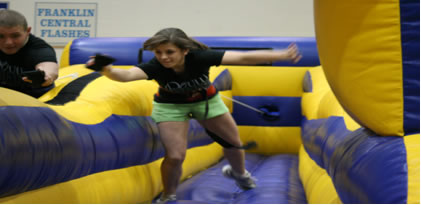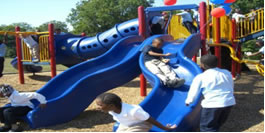|
 Bold
Movement in the Face of Obesity Bold
Movement in the Face of Obesity
By: Lisa
Perry, NBCT Early/Middle Childhood
PE , National Physical Education &
Physical Activity Manager
Childhood obesity is one of our nation’s
leading health threats. Today, 25 million
kids are overweight or obese. The obesity
epidemic is clearly taking its toll
as more and more kids are developing
conditions and diseases that we would
typically not see until adulthood, such
as high blood pressure, elevated cholesterol,
and type-2 diabetes.
Some experts believe that if childhood
obesity rates continue to increase,
the current generation could become
the first Americans in history to live
shorter lives than their parents.
 To
combat this growing epidemic, the American
Heart Association and the William J.
Clinton Foundation joined together in
2005 to form the Alliance
for a Healthier Generation. The
goal of the Alliance is to stop the
nationwide increase in childhood obesity
by 2010 by taking bold, innovative steps
to help all children live longer and
healthier lives. To
combat this growing epidemic, the American
Heart Association and the William J.
Clinton Foundation joined together in
2005 to form the Alliance
for a Healthier Generation. The
goal of the Alliance is to stop the
nationwide increase in childhood obesity
by 2010 by taking bold, innovative steps
to help all children live longer and
healthier lives.
In short, the Alliance’s mission
is to “Eliminate childhood obesity
and inspire young people in the United
States to develop lifelong, healthy
habits.” To achieve this mission,
the Alliance has four multifaceted initiatives
which are positively affecting the places
that can make a difference to a child’s
health including homes, schools, restaurants,
doctors’ offices and other places
throughout their community:
- The health care industry spends
$61 billion a year to treat obesity-related
ailments. The Alliance’s Healthcare
Initiative is working to
broker voluntary agreements with health
insurers and self-insured employers
to reimburse for diagnosis and treatment
directed at reducing or preventing
childhood obesity.
- The Kids
Movement is empowering kids
across the country to take charge
of their own health. Kids can access
tools and resources at www.igohugo.org.
The Movement aims to make healthy
lifestyles “cool” for
tweens and teens through collaboration
with media celebrities and grassroots
partners. At the forefront of the
Movement is the “myGo Healthy
Challenge,” an online game-like
learning experience to get kids excited
about healthy eating and active living.
- The Industry
Initiative has collaborated
with several leading companies and
trade associations in the food and
beverage industries to develop and
implement guidelines for beverages
and competitive foods sold in schools.
To date, the Alliance has brokered
agreements with 30 companies and trade
associations in the beverage, food
and dairy industries, resulting in
a 58 percent decrease in calories
in the beverage products shipped to
schools.
- The Healthy
Schools Program provides
real tools and solutions for schools
to become healthier places for the
53 million students and staff who
learn and work in our nation’s
schools everyday.
A Closer Look at the Healthy
Schools Program
 The
Healthy Schools Program provides support
to schools in their efforts to engage
the entire school community (administrators,
parents, and school vendors) in increasing
access to physical activity and healthier
foods for students and staff. In addition
to providing schools with best practices,
resources and support, the Healthy Schools
Program helps schools celebrate their
successes through a national recognition
program. The
Healthy Schools Program provides support
to schools in their efforts to engage
the entire school community (administrators,
parents, and school vendors) in increasing
access to physical activity and healthier
foods for students and staff. In addition
to providing schools with best practices,
resources and support, the Healthy Schools
Program helps schools celebrate their
successes through a national recognition
program.
The Healthy Schools Program Framework
provides guidance to schools on implementing
the best practice, sustainable changes
in the school environment. A major tenet
of the HSP Framework includes addressing
and reinforcing the critical link between
access to improved nutrition and physical
activity and increased academic performance.
For example, the criteria on physical
education addresses time spent in physical
education classes, licensure requirements
for teachers, instructional strategies,
curriculum, and student/teacher ratios.
The physical activity criteria includes
recess, integrating opportunities for
physical activity throughout the school
day, and working to promote safe walking
and biking to school. Other areas of
focus for HSP members are: School Meals,
Competitive Foods and Beverages, School
Employee Wellness, Health Education,
and Before & Afterschool programs.
Building healthier school environments
is one of the most efficient and effective
ways to shape the lifelong health and
well-being of children and adolescents.
Any school in the nation can join the
movement to build healthier schools
by joining the Healthy Schools Program
at no cost. Here are a few things the
Healthy Schools Program has to offer
its member schools:
- National Recognition
to help celebrate small victories
and big successes
- Customized
Support to help create a
healthier school environment through
a liaison available by phone and email
-
Implementation Support and Tools
that are robust and informative to
help schools to achieve lasting change
-
Networking Opportunities
with schools across the country on
the quest for a healthier school
- A Resource
Database that includes quality
resources and grant opportunities
to suit every school’s work
to implement healthy changes that
promote physical activity and healthy
eating
 The
Healthy Schools Program is currently
active in all 50 states, reaching nearly
3,000 schools and 1.66 million students.
Any school - public, private or charter
- in the country can join the Healthy
Schools Program online at no cost. To
learn more about the Healthy Schools
Program and to find out if there is
a program in your district and/or school,
visit www.HealthierGeneration.org/Schools
or call 1-888-KID-HLTH. The
Healthy Schools Program is currently
active in all 50 states, reaching nearly
3,000 schools and 1.66 million students.
Any school - public, private or charter
- in the country can join the Healthy
Schools Program online at no cost. To
learn more about the Healthy Schools
Program and to find out if there is
a program in your district and/or school,
visit www.HealthierGeneration.org/Schools
or call 1-888-KID-HLTH.
The Alliance for a Healthier Generation
wants to celebrate and share innovative
solutions that schools around the country
have successfully implemented to improve
school health. Here are some great examples:
A
Dedicated PE Teacher Champions Physical
Activity
Kennedy Elementary School
Green Bay, WI
At Kennedy Elementary in Green Bay,
Wisconsin, great things are happening
when it comes to student health and
wellness. PE teacher Mary Buchholz
has been hard at work finding ways
to increase students’ physical
activity time during the school day.
For example, she worked with the principal
to increase students’ weekly
PE time from 60 to 90 minutes. She
did this by adding a 30-minute weekly
PE class to the classroom teachers’
schedule, which is in addition to
the 60 minutes per week that students
spend in PE with her already. Under
this arrangement, Ms. Buchholz provides
the curriculum, and the teachers deliver
the lessons in their classrooms. Ms.
Buchholz has also formed a recess
walking club, in which students walk
in laps around the field during the
post-lunch recess, and she goes out
of her way to encourage students to
join in. Students are excited about
the changes, and they often ask for
their special monthly reward events
to focus on more health and physical
activity time.
President
Clinton Inspires Sweetwater to Take
Bold Action
Sweetwater County School District
Green River, Wyoming
When members of the Sweetwater County
School District (SCSD) #2 School Board
heard Former President Bill Clinton
speak at last year’s National
School Board Association Annual Conference,
they were inspired to promote a strong
wellness policy in their district.
The President’s remarks on childhood
obesity and the need for school districts
to take a strong stand for their students’
health resonated with these leaders,
and they have been implementing some
broad changes - especially within
the school nutrition environment.
At
school athletic events where adults
are present, soda is now only available
in 12 ounce servings and is the same
price as a 20 ounce bottle of water.
The board is confident that by using
a price incentive many more people
will make the healthier choice. A
proposal to sell only healthy snacks
at afterschool athletic events was
met with some hesitation by community
members concerned about the potential
loss of revenue. The board showed
just how committed it is when it stepped
up and offered $10,000 to offset the
potential loss because they felt it
was a small price to pay for school
health!
Participation
in the school meal program has been
on the rise and menus have shifted
to more whole grain and lower-fat
options. The district has adopted
the Alliance’s School Beverage
Guidelines and has removed all sodas
from school vending machines. The
district’s wellness policy urges
students to “receive consistent
nutrition messages throughout the
school, classroom, and cafeteria,”
and calls for the cafeteria to offer
a “learning laboratory”
to link the lessons learned in class
with the practice of making healthy
choices.
In addition
to its progress in the nutrition arena,
SCSD #2 also purchased a large-sized
Dance Dance Revolution video game
stage and 30 mountain bikes, upgraded
its weight rooms, and gave every student
a pedometer. The district’s
focus this year is on staff wellness,
with several activities scheduled,
including monthly jogs. A point system
has been set up so staff members can
earn T-shirts or other rewards for
every 100 miles logged. Sweetwater
County is definitely on its way to
becoming a healthier community.
Mini-Marathons
for Students and Staff
Delaware Valley Middle School
Milford, Pennsylvania
Last
summer, Pete Ioppolo, the wellness
coordinator for the Delaware Valley
School District and the principal
of Delaware Valley Middle School,
attended the Healthy Schools Forum
in Little Rock, Arkansas. He was quite
impressed with the forum, and while
there, he and a colleague took the
opportunity to interact with many
of the guest speakers.
His
conversation with Arkansas Governor
Mike Huckabee, about the governor’s
experiences running marathons, was
especially meaningful. How, the coordinator
asked, could we get the students in
our district involved? Governor Huckabee
suggested mini-marathon runs in two-mile
increments to achieve the goal of
completing 26.2 miles—a whole
marathon.
Upon his
return to school, Principal Ioppolo
acted on Governor Huckabee’s
suggestion. This year, approximately
40 middle school students, along with
several staff, meet on Tuesdays after
school. They’re currently in
week eleven of their quest to complete
the 13-week mini-marathon. The marathon
will culminate on Saturday, April
9, in conjunction with the Delaware
Valley Health Advisory Council sponsoring
the Delaware Valley School District’s
first annual 5K Race/Walk. Principal
Ioppolo believes that his experience
at the Healthy Schools Forum created
a life-long impression. He and the
entire Delaware Valley School District
team continue to be ardent supporters
of the Healthy Schools Program.
Walking
the Green
Flagami Elementary
Miami, Florida
Every Friday at Flagami Elementary,
students, staff, and even some neighbors,
don green t-shirts and incorporate
more physical activity into their
daily routine by “Walking the
Green.” This event began as
a one-time activity where the school
community walked around their large
field showing solidarity for eating
healthy and participating in physical
exercise but it was so popular they
decided to continue it.
Students
report that they enjoy the walk because
it gives them more energy and makes
them feel healthy. Teachers say they
wish they could walk even more. They
also comment on how the walk invigorates
the students and prepares them for
learning in school.
In
addition to the weekly walk, every
day after the school’s morning
announcements, students and staff
stretch together with an exercise
video produced by the School Wellness
Council, with help from the school
media specialist.
The
principal from Flagami Elementary
attended the Healthy Schools Forum
in 2006 and came back enthusiastic
about making big changes in the school
environment. Her excitement has spread
to students, the PTA, and the surrounding
community. Flagami Elementary plans
to keep working on making changes
to improve the health of their school.
Captions
for Photos:
Earhart: Amelia Earhart Elementary School,
Miami, Florida
Bell Bell Ave Elementary School, Yeadon,
Pennsylvania
Perry Perry Meridian High School, Indianapolis,
Indiana
Longleaf Longleaf Elementary School,
Pensacola, Florida
For any questions or comments please
contact Lisa Perry at lisa.perry@healthiergeneration.org
(pelinks4u
home) |



